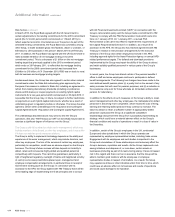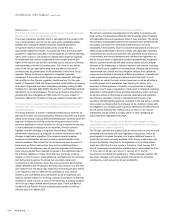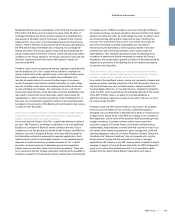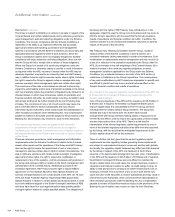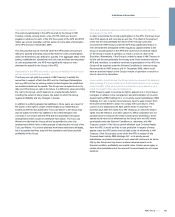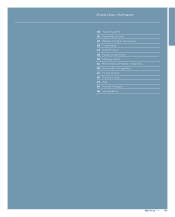RBS 2010 Annual Report Download - page 415
Download and view the complete annual report
Please find page 415 of the 2010 RBS annual report below. You can navigate through the pages in the report by either clicking on the pages listed below, or by using the keyword search tool below to find specific information within the annual report.
The value of certain financial instruments recorded at fair value is
determined using financial models incorporating assumptions,
judgements and estimates that may change over time or may ultimately
not turn out to be accurate.
Under IFRS, the Group recognises at fair value: (i) financial instruments
classified as “held-for-trading” or “designated as at fair value through
profit or loss”; (ii) financial assets classified as “available-for-sale”; and (iii)
derivatives. Generally, to establish the fair value of these instruments, the
Group relies on quoted market prices or, where the market for a financial
instrument is not sufficiently active, internal valuation models that utilise
observable market data. In certain circumstances, the data for individual
financial instruments or classes of financial instruments utilised by such
valuation models may not be available or may become unavailable due to
changes in market conditions, as has been the case during the recent
financial crisis. In such circumstances, the Group’s internal valuation
models require the Group to make assumptions, judgements and
estimates to establish fair value. In common with other financial
institutions, these internal valuation models are complex, and the
assumptions, judgements and estimates the Group is required to make
often relate to matters that are inherently uncertain, such as expected
cash flows, the ability of borrowers to service debt, residential and
commercial property price appreciation and depreciation, and relative
levels of defaults and deficiencies. Such assumptions, judgements and
estimates may need to be updated to reflect changing facts, trends and
market conditions. The resulting change in the fair values of the financial
instruments has had and could continue to have a material adverse effect
on the Group’s earnings and financial condition.
Also, recent market volatility and illiquidity have challenged the factual
bases of certain underlying assumptions and have made it difficult to
value certain of the Group’s financial instruments. Valuations in future
periods, reflecting prevailing market conditions, may result in further
significant changes in the fair values of these instruments, which could
have a material adverse effect on the Group’s results of operations and
financial condition or result in a loss of value in the Securities.
The Group operates in markets that are highly competitive and
consolidating. If the Group is unable to perform effectively, its business
and results of operations will be adversely affected.
The consolidation that has taken place in recent years among banking
institutions in the UK, the US and throughout Europe continues to change
the competitive landscape for banks and other financial institutions. If
financial markets continue to be volatile, more banks may be forced to
consolidate. This consolidation, in combination with the introduction of
new entrants into the US and UK markets from other European and Asian
countries, could increase competitive pressures on the Group.
In addition, certain competitors may have access to lower cost funding
and/or be able to attract retail deposits on more favourable terms than the
Group and may have stronger multi-channel and more efficient
operations as a result of greater historical investments. Furthermore, the
Group’s competitors may be better able to attract and retain clients and
key employees, which may have a negative impact on the Group’s
relative performance and future prospects.
Furthermore, increased government ownership of, and involvement in,
banks generally may have an impact on the competitive landscape in the
major markets in which the Group operates. The effects of the substantial
government shareholding and involvement in the banks may differ from
jurisdiction to jurisdiction, and such involvement may cause the Group to
experience stronger competition for corporate, institutional and retail
clients and greater pressure on profit margins. Future disposals and
restructurings by the Group and the compensation structure and
restrictions imposed on the Group may also have an impact on its ability
to compete effectively. Since the markets in which the Group operates
are expected to remain highly competitive in all areas, these and other
changes to the competitive landscape could adversely affect the Group’s
business, margins, profitability, financial condition and prospects or result
in a loss of value in the Securities.
As a condition to HM Treasury support, the company has agreed to
certain undertakings which may serve to limit the Group’s operations.
Under the terms of the First Placing and Open Offer, the company
provided certain undertakings aimed at ensuring that the subscription by
HM Treasury of the relevant ordinary shares and preference shares and
the Group’s participation in the Credit Guarantee Scheme offered by HM
Treasury as part of its support for the UK banking industry are compatible
with the common market under EU law. These undertakings included (i)
certain lending commitments in relation to UK residential mortgage
lending and lending to SMEs in the UK until 28 February 2011, (ii)
regulating management remuneration and (iii) regulating the rate of
growth of the Group’s balance sheet. Under the terms of the placing and
open offer undertaken by the company in April 2009 (the “Second Placing
and Open Offer”), the Group’s undertakings in relation to mortgage
lending and lending to SMEs were extended to larger commercial and
industrial companies in the UK. Pursuant to these arrangements, the
Group agreed to make available to creditworthy borrowers on commercial
terms, £16 billion above the amount the company had budgeted to lend
to UK businesses and £9 billion above the amount the company had
budgeted to lend to UK homeowners in the year commencing 1 March
2009.
In relation to the 2009 commitment period, which ended on 28 February
2010, the Group’s net mortgage lending to UK homeowners was £12.7
billion above the amount it had originally budgeted to lend. In relation to
its business lending commitment, the Group extended £41 billion of gross
new facilities, drawn and undrawn, to UK businesses, including £27
billion to SMEs but, in the economic environment prevailing at the time,
many customers were strongly focused on reducing their borrowings and
repayments consequently increased. Moreover, the withdrawal of foreign
lenders was less pronounced than anticipated, there was a sharp
increase in capital market issuance and demand continued to be weak.
As a result, the Group’s net lending did not reach the £16 billion targeted.
413RBS Group 2010
Additional information













